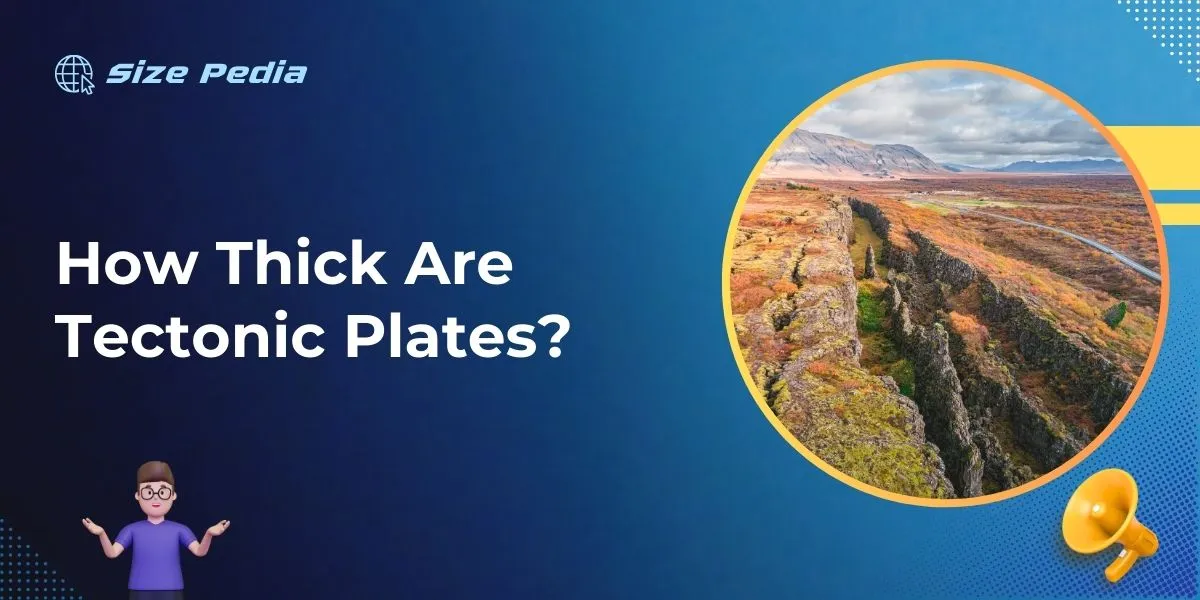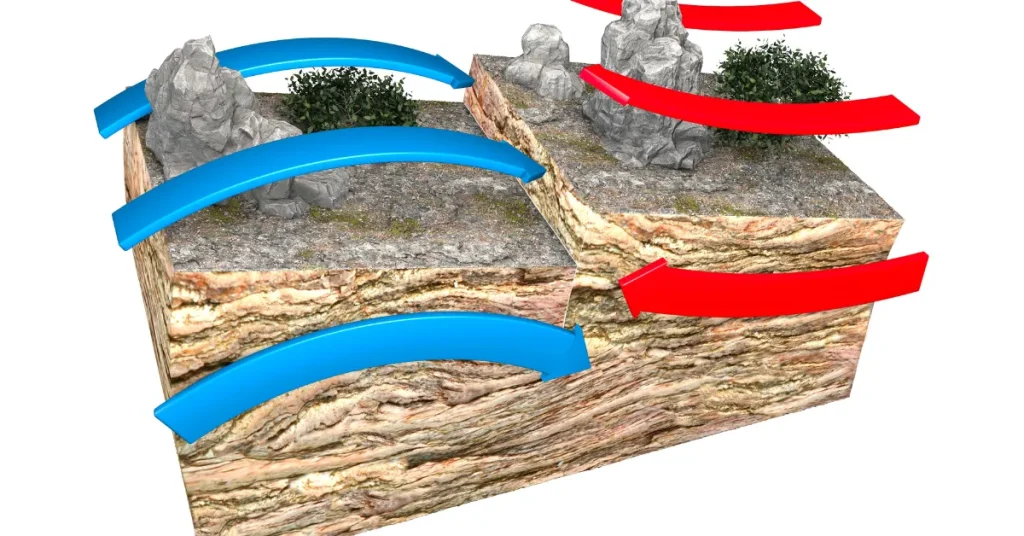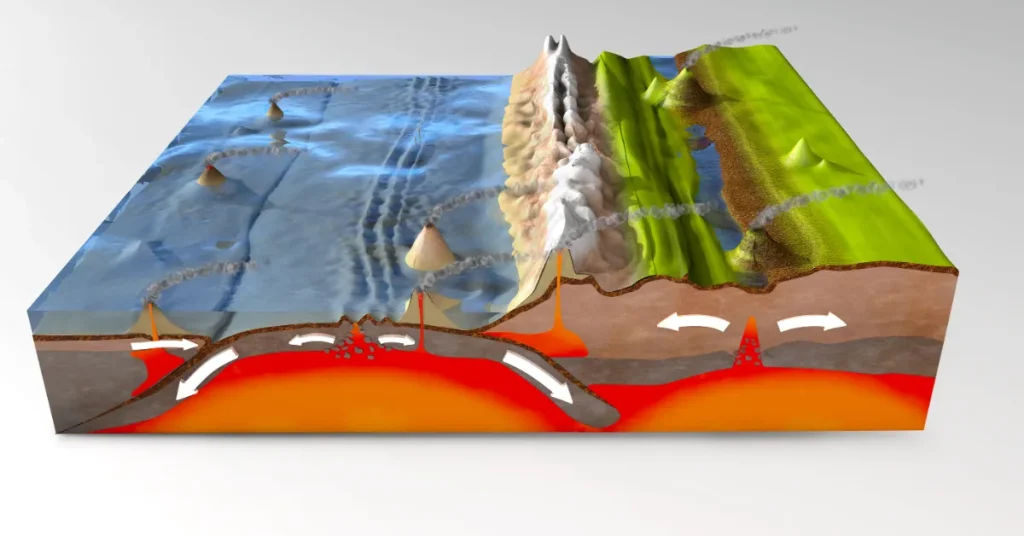Tectonic plates typically range from 5 to 100 kilometers in thickness. Oceanic plates are thinner, averaging around 5 to 10 kilometers, while continental plates are thicker, generally ranging from 30 to 100 kilometers.
Understanding the thickness of tectonic plates is fundamental in the study of geology. These massive slabs of Earth’s lithosphere float on the semi-fluid asthenosphere beneath them, driving the dynamic processes that shape our planet.
Their thickness varies depending on whether they are beneath the oceans or form the continents.
Oceanic plates tend to be comprised of dense basaltic rocks, while continental plates are made up of lighter granitic rocks, which contributes to the discrepancy in their thickness.
The study of these plates not only informs us about earth’s geological history but also helps in predicting seismic activity and volcanic eruptions. For geologists, plate tectonics is a window into the past and a tool for forecasting future geodynamic events.

Earth’s Mighty Shields: Tectonic Plate Thickness
The Earth is safeguarded by enormous rocky slabs called tectonic plates. These plates float on a viscous layer beneath.
Their thickness is vital for understanding earthquakes, volcanoes, and mountain formation. Get ready to dive deep into the world of Earth’s protective layers.
The Skin Of Our Planet: Tectonic Plates Unveiled
Tectonic plates are like the skin of our planet. But unlike skin, they are immensely thick. These plates come in two types:
- Oceanic plates – usually about 5 to 10 kilometers thick
- Continental plates – typically range from 30 to 50 kilometers thick
Some areas, called subduction zones, can have plates over 100 kilometers thick!
Measuring The Might: Techniques To Gauge Plate Thickness
Scientists use special tools to measure plate thickness:
- Seismic waves – They study how waves move through Earth’s layers
- Satellites – These can measure variations in gravitational pull caused by plate density
- Drilling projects – They take direct measurements by drilling into Earth’s crust
Variations In Plate Thickness: A World Beneath Our Feet
The earth is like a giant puzzle. Imagine pieces that float on a hot, flowing rock layer. These pieces are tectonic plates.
They have different thicknesses. The ground below us is more than just dirt. It’s a complex layer of these plates, which vary in depth. World maps can’t show this third dimension. We can’t see this world beneath our feet. But with science, we can explore it.
Oceanic Vs Continental: Contrasting Plate Profiles
The earth’s crust has two main kinds of plates: oceanic and continental.
They’re different in make-up and thickness. Oceanic plates are usually about 100km thick.
Continental plates can be up to 200km thick. These are the plates under land we live on.
- Oceanic Plates:
- Made mostly of basalt
- Denser and thinner
- Underlies the ocean basins
- Continental Plates:
- Composed largely of granite
- Less dense but thicker
- Forms the continents and landmasses
Geographical Anomalies: Exploring Thickness Discrepancies
Anomalies are strange things that don’t fit the pattern. Our world has lots of these. Plate thickness is different in many places. Why? Many reasons like mountains, faults, and hotspots change plate thickness. Let’s look at some examples:
| Location | Type of Plate | Estimated Thickness |
| Himalayas | Continental | 70km-100km |
| Mid-Atlantic Ridge | Oceanic | 6km-25km |
| Hawaiian Islands | Oceanic | Varying due to hotspot |
These examples show plate thickness is not the same everywhere.
Studying these discrepancies helps us understand our Earth better.
It helps us predict events like earthquakes and volcanic eruptions.
Formation And Evolution: The Lifecycle Of Tectonic Plates

The Earth is an ever-evolving planet, and its tectonic plates have a lifecycle as dynamic as life itself. Tectonic plates are massive, irregularly shaped slabs of solid rock. They float atop the semi-fluid asthenosphere, beneath the Earth’s crust.
The formation, evolution, and eventual recycling of these plates play a pivotal role in shaping our planet’s surface.
Born From Fire: The Genesis Of Tectonic Plates
Tectonic plates emerge from the intense heat within the Earth’s mantle. This heat causes molten rock, called magma, to rise toward the surface. As it cools, it forms new crust.
This process occurs at divergent boundaries where two plates move apart. The most well-known example is the mid-oceanic ridge system.
Newly born plates are relatively thin. They thicken as they age, due to cooling and additional magma layering atop the existing crust.
A Tale Of Eons: The Changing Thickness Over Geologic Time
As tectonic plates journey across the planet, their thickness varies. This variation depends on the plate’s age and tectonic history. Drastic changes unfold over millions of years.
Beginning as thin layers, continental plates can grow to be 70 to 100 kilometers thick. Oceanic plates start off at about 5 to 10 kilometers thick and may reach up to 100 kilometers thick near subduction zones where they are forced under another plate.
| Plate Type | Initial Thickness | Potential Maximum Thickness |
| Continental | 20-40 km | 70-100 km |
| Oceanic | 5-10 km | Up to 100 km |
Continental plates are generally thicker than oceanic plates. This is because they are composed of less dense materials and have a longer lifecycle.
The Role In Earth’s Dynamics: What Thickness Determines
Tectonic plates are massive slabs of solid rock. They form Earth’s outer shell. Their thickness affects how they move and interact. Imagine Earth as a giant machine. Tectonic plates are parts that fit together. Their thickness makes sure they work right.
Movement And Interaction: How Thickness Drives Tectonic Activity
The Earth is like a puzzle. Plates fit and move. Thick plates can be slow to move. Thin plates are more flexible. This difference in thickness means:
- Thick plates might lock together, not moving for years.
- Thin plates can slide and bend more easily.
This is important because it changes how Earth’s surface looks over time. Mountains form, oceans shift, and continents drift all because of the power of plate thickness.
Cataclysmic Consequences: Earthquakes And Plate Thickness
When thick plates eventually move, the results can be huge. Earthquakes shake the ground.
Cities can be damaged. They happen when plates that got stuck suddenly break free. Plate thickness is a key reason for the strength of an earthquake.
| Plate Thickness | Potential Earthquake Magnitude |
| Thicker Plates | Stronger Quakes |
| Thinner Plates | Lesser Quakes |
This table shows a simple link between thickness and earthquakes. Remember, the crucial role plate thickness plays in shaping our world cannot be overlooked.
Advanced Exploration: Cutting-edge Research And Discoveries
Unlocking the mysteries of Earth’s internal structure is a constant quest in geology. Tectonic plates are massive, but their thickness can vary dramatically. Recent advances in technology have propelled our understanding to new heights.
Cutting-edge research and tools allow us to see beneath the surface like never before. Let’s dive into the latest innovations that are reshaping what we know about tectonic plates.
Seismic Surveys And Satellites: Innovations In Plate Study
Seismic surveys use sound waves to map the Earth’s subsurface. These surveys have identified the varied thickness of tectonic plates.
Initial studies revealed a range between 5 kilometers in oceanic regions to 70 kilometers beneath continental landscapes. Today’s high-resolution seismic data allows us to create 3D models of plate boundaries and interiors.
Satellite technology also plays a pivotal role. The GRACE satellites, for example, can detect minute changes in Earth’s gravity field. These changes help indicate shifts in plate mass and can suggest changes in their thickness.
- Seismic surveys penetrate deep, offering precise details about plate characteristics.
- Satellites track gravity anomalies, indirectly informing on plate thickness.
This combination of seismic and satellite data brings a new understanding to the field of tectonics. Scientists can now identify previously undetectable features of the Earth’s crust.
Future Prospects: Predicting Changes In Plate Thickness

Research doesn’t stop with current findings. The ultimate goal is to anticipate future changes in plate thickness. This could have major implications for earthquake preparedness and resource management.
Continued innovations will likely provide us with tools to make such predictions possible. Researchers are hopeful that machine learning algorithms could analyze complex data to forecast changes.
Scientists also expect that long-term monitoring will play a key role in understanding plate dynamics. This would include changes in plate thickness over time. New tools and methodologies are emerging to support these efforts:
- Higher resolution imaging: More detailed seismic data can reveal micro-changes in plate structure.
- Sensors: Advanced sensors on the ocean floor measure the bending and stretching of plates.
- Computational models: These models can simulate millions of years of plate interactions to project future movements.
The integration of these technologies hopes to lead us to a world where we can foresee and adapt to the Earth’s continuous transformation beneath our feet.
Humanity’s Understanding: Implications Of Plate Thickness Knowledge
Learning how thick tectonic plates are tells us a lot. It helps us understand earthquakes, volcanoes, and even life on other worlds. Let’s dive into the importance of this knowledge.
Confronting Natural Disasters: Preparedness And Plate Dynamics
Earth’s outer shell is not one piece. It is made up of big, moving plates. When two plates move, they can cause earthquakes.
Knowing the thickness of these plates is key. It helps us build safer homes and cities. Scientists can tell us where it’s safe to build.
Thin plates might crack easier than thick ones. This is important for places near plate edges.
- Thin plates: More bending, could mean more quakes.
- Thick plates: Less bending, but might make bigger quakes when they snap.
The thickness can vary from 5 kilometers to 100 kilometers.
We study this to make better emergency plans. This can save lives.
Beyond Earth: Plate Tectonics In The Search For Exoplanets
Plate tectonics might help us find life outside Earth. Scientists look for earthy planets with moving plates like ours.
Why? Because on Earth, moving plates help life. They create mountains and oceans.
- Moving plates can mean a planet is alive inside.
- Volcanoes from plate movement can make air and water.
- Life-friendly climates might happen with plate tectonics.
Finding plates far away means we might find new homes in space one day.
FAQs About How Thick Are Tectonic Plates
How Many Miles Thick Is A Tectonic Plate?
Tectonic plates vary in thickness from around 15 miles (24 kilometers) to 200 miles (320 kilometers).
How Thick Are The Continental Plates?
Continental plates typically range between 30 to 50 kilometers in thickness. These extensive layers make up Earth’s land masses and underlying crust.
Are The Tectonic Plates 62 Feet Thick?
No, tectonic plates vary in thickness from roughly 7 kilometers (about 23 feet) in oceanic regions to about 70 kilometers (43 miles) in continental areas.
How Dense Are Tectonic Plates?
Tectonic plates have an average density of about 2. 7 to 3. 3 grams per cubic centimeter. They consist of the earth’s lithosphere, encompassing both continental and oceanic crust.
Conclusion
Understanding tectonic plate thickness is essential for grasping Earth’s geological dynamics. Plate thickness varies, typically ranging from 15 to 200 kilometers.
This knowledge allows geologists to predict seismic activity and comprehend mountain formation. As our planet’s lifeblood, tectonic plates shape the landscape and remind us of the ever-changing world beneath our feet.
Resources:
1. https://www.usgs.gov/educational-resources/plate-tectonics
